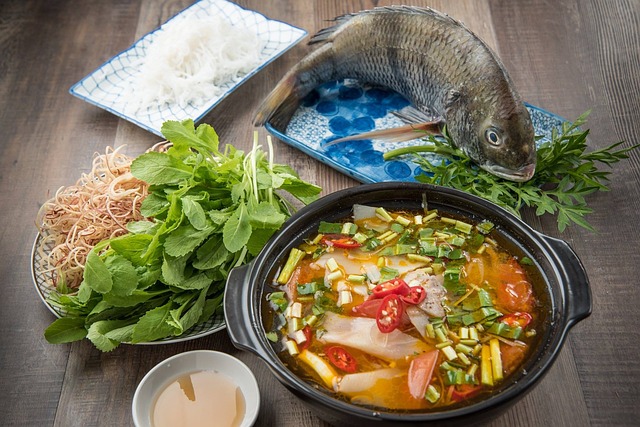
Embracing a healthy lifestyle is a journey—one that doesn’t have to be at odds with enjoying flavorful and fulfilling meals. By mastering the art of healthy home cooking, you can revitalize your life, infusing it not only with essential nutrients but also with joy, creativity, and a sense of accomplishment. This comprehensive guide will inspire and empower you to adopt habits that contribute to a balanced and fulfilling life through the alchemy of the kitchen.
Understanding the Pillars of Healthy Eating
Nourish Your Body: At its core, healthy eating is about nourishing your body with the right balance of nutrients. This includes a variety of vitamins, minerals, proteins, carbohydrates, and healthy fats. These foundational elements support your body’s systems, boost energy levels, and help in the maintenance of overall health.
Maintain Balance: Rather than subscribing to restrictive diets, focus on moderation and balance. This means incorporating a diverse range of foods into your diet so that you can enjoy all the flavors nature has to offer while obtaining a wide spectrum of nutrients.
Practice Mindfulness: Being mindful about what you eat involves paying attention to your body’s signals, understanding the source of your ingredients, and recognizing the impact of your food choices on your well-being and the environment.
The Benefits of Home Cooking
Cooking at home allows you complete control over what goes into your meals, enabling you to avoid excess sodium, sugars, and unhealthy fats commonly found in processed foods. The benefits extend beyond health:
-
- Economical: Preparing meals at home can be more cost-effective than eating out.
-
- Educational: It empowers you to learn about nutrition and culinary skills.
-
- Customizable: You can adjust recipes to suit dietary needs and taste preferences.
Setting Up for Success: The Healthy Home Kitchen
Setting up your kitchen with the right ingredients, tools, and mindset is the first step to mastering healthy home cooking.
Stock a Flavorful and Nutritious Pantry
Ensure you have the following staples on hand:
-
- Whole grains like quinoa, brown rice, and oats
-
- A variety of beans and legumes
-
- Nuts, seeds, and their butters
-
- Herbs and spices to add flavor without the need for excess salt
-
- Healthy oils such as olive and avocado oil
Equip Your Kitchen with Essential Tools
Invest in quality kitchenware to make cooking a breeze:
-
- Sharp knives
-
- Cutting boards
-
- A set of non-stick or cast-iron cookware
-
- Measuring cups and spoons
-
- A blender or food processor
Cooking Techniques for Maximum Nutrition
Preserve nutrients and boost taste using the following methods:
Steaming and Blanching
Great for vegetables, these techniques maintain crunch and nutrient content while brightening colors.
Sauteing and Stir-frying
Quick and conducted over high heat, these methods lock in flavors and can be made healthy with the use of minimal and healthy oils.
Roasting and Grilling
These cooking methods add a depth of smoky and caramelized flavor, eliminating the need for heavy sauces or dressings.
Exploring Flavors to Enhance Enjoyment
Smart Seasoning Strategies
Herbs, spices, garlic, onion, citrus, and vinegar can add layers of flavor without unnecessary calories or sodium.
International Cuisine Inspirations
Discover healthy recipes worldwide, integrating unique ingredients and spices that expand your palate and enrich your diet.
Balance of Flavor Components
Focusing on the balance between salty, sweet, sour, bitter, and umami tastes can lead to satisfying dishes that don’t rely on unhealthy additives.
Planning for Lasting Wellness
Meal Planning and Prep
Developing a weekly meal plan and prepping ingredients ahead of time increase the likelihood that you’ll stick to healthy eating habits. This reduces last-minute stress and reliance on less healthy convenience foods.
Smart Snacking
Keep healthy snacks readily available to fuel your body between meals and prevent overeating. Think fresh fruit, vegetables, nuts, and whole-grain options.
Incorporating Mindfulness into Mealtime
Mindful Eating Practices
Eating slowly, chewing thoroughly, and eliminating distractions can enhance your dining experience, improve digestion, and lead to better portion control.
The Spirit of Gratitude
Acknowledging the effort behind each meal cultivates an attitude of gratitude, fostering a deeper connection to your food and its origins.
Family and Community Engagement Through Cooking
Involve family and friends in the cooking process—this not only builds relationships but also allows the exchange of ideas and techniques, enriching your culinary repertoire further.
Persistence and Patience: The Journey of Self-Discovery
As you grow in your healthy cooking skills, remain patient with yourself. Experiment with new foods, learn from mishaps, and celebrate your victories, no matter how small.
Conclusion: The Symphony of Healthy Home Cooking
Healthy home cooking is a fusion of art and science—a symphony of flavors, textures, and colors that, when mastered, can be enormously satisfying and revitalizing. It’s not just about sustenance; it’s about living a life filled with vibrancy, pleasure, and wellness. The journey of mastering the art of healthy home cooking is ongoing, one that evolves with every meal and every choice. Begin this journey with a spirit of adventure, and watch as your life transforms with the simple, yet profound act of cooking at home.
By embracing these principles and practices, you are setting the stage for a lifetime of health, joy, and flavorful exploration. Here’s to your lasting wellness—both on and off the plate!







Al great deal for a web developer. Details: https://zetds.seychellesyoga.com/var_montero
Al great deal for a web developer. Details: https://zetds.seychellesyoga.com/var_montero
Al great deal for a web developer. Details: https://zetds.seychellesyoga.com/var_montero
The offer is still valid. Details https://zetds.seychellesyoga.com/jml
Content for your website https://zetds.seychellesyoga.com/info
Web Development Wizards https://zetds.seychellesyoga.com/info
Can provide a link mass to your website https://zetds.seychellesyoga.com/info
Your site’s position in the search results https://zetds.seychellesyoga.com/info
Free analysis of your website https://zetds.seychellesyoga.com/info
Content for your website https://zetds.seychellesyoga.com/info
Web Development Wizards https://zetds.seychellesyoga.com/info
Can provide a link mass to your website https://zetds.seychellesyoga.com/info
Your site’s position in the search results https://zetds.seychellesyoga.com/info
Free analysis of your website https://zetds.seychellesyoga.com/info
SEO Optimizers Team https://zetds.seychellesyoga.com/info
I offer mutually beneficial cooperation https://zetds.seychellesyoga.com/info
Cool website. There is a suggestion https://zetds.seychellesyoga.com/info
Here’s what I can offer for the near future https://zetds.seychellesyoga.com/info
You will definitely like it https://zetds.seychellesyoga.com/info
Content for your website https://ztd.bardou.online/adm
Web Development Wizards https://ztd.bardou.online/adm
Can provide a link mass to your website https://ztd.bardou.online/adm
Your site’s position in the search results https://ztd.bardou.online/adm
Free analysis of your website https://ztd.bardou.online/adm
SEO Optimizers Team https://ztd.bardou.online/adm
I offer mutually beneficial cooperation https://ztd.bardou.online/adm
Cool website. There is a suggestion https://ztd.bardou.online/adm
I really liked your site. Do you mind https://ztd.bardou.online/adm
Here’s what I can offer for the near future https://ztd.bardou.online/adm
Content for your website https://ztd.bardou.online/adm
Web Development Wizards https://ztd.bardou.online/adm
Can provide a link mass to your website https://ztd.bardou.online/adm
Your site’s position in the search results https://ztd.bardou.online/adm
Free analysis of your website https://ztd.bardou.online/adm
SEO Optimizers Team https://ztd.bardou.online/adm
I offer mutually beneficial cooperation https://ztd.bardou.online/adm
Cool website. There is a suggestion https://ztd.bardou.online/adm
Content for your website http://myngirls.online/
Web Development Wizards http://myngirls.online/
Can provide a link mass to your website http://myngirls.online/
Your site’s position in the search results http://myngirls.online/
Free analysis of your website http://myngirls.online/
SEO Optimizers Team http://myngirls.online/
I offer mutually beneficial cooperation http://myngirls.online/
Content for your website http://fertus.shop/info/
Web Development Wizards http://fertus.shop/info/
Can provide a link mass to your website http://fertus.shop/info/
Your site’s position in the search results http://fertus.shop/info/
Free analysis of your website http://fertus.shop/info/
SEO Optimizers Team http://fertus.shop/info/
I offer mutually beneficial cooperation http://fertus.shop/info/
Cool website. There is a suggestion http://fertus.shop/info/
I really liked your site. Do you mind http://fertus.shop/info/
Here’s what I can offer for the near future http://fertus.shop/info/
You will definitely like it http://fertus.shop/info/
The best prices from the best providers http://fertus.shop/info/
Additional earnings on your website http://fertus.shop/info/
After The Vladimir Putin Interview Interview Putin. Does Vladimir Putin Speak English.
Analytics of your website http://fertus.shop/info/
I would like to post an article http://fertus.shop/info/
How to contact the administrator on this issue http://fertus.shop/info/
Shall we exchange links? My website http://fertus.shop/info/
The offer is still valid. Details http://fertus.shop/info/
We offer cooperation on SEO optimization http://fertus.shop/info/
Content for your website http://fertus.shop/info/
Web Development Wizards http://fertus.shop/info/
uvi9y3
Can provide a link mass to your website http://fertus.shop/info/
Web Development Wizards http://fertus.shop/info/
Your site’s position in the search results http://fertus.shop/info/
SEO Optimizers Team http://fertus.shop/info/
https://images.google.co.tz/url?q=https://batmanapollo.ru/ http://google.com.lb/url?q=https://batmanapollo.ru/ http://images.google.rs/url?q=https://batmanapollo.ru/ https://images.google.gy/url?q=https://batmanapollo.ru/ http://maps.google.sm/url?q=https://batmanapollo.ru/ http://maps.google.com.eg/url?q=https://batmanapollo.ru/ https://www.google.net/url?q=https://batmanapollo.ru/ http://www.google.st/url?q=https://batmanapollo.ru/ https://maps.google.co.ke/url?q=https://batmanapollo.ru/ https://www.google.nl/url?q=https://batmanapollo.ru/ https://maps.google.com.ai/url?q=https://batmanapollo.ru/ https://images.google.ge/url?q=https://batmanapollo.ru/ https://images.google.at/url?q=https://batmanapollo.ru/ https://maps.google.lk/url?q=https://batmanapollo.ru/ https://images.google.co.id/url?q=https://batmanapollo.ru/ https://images.google.com.kw/url?q=https://batmanapollo.ru/ http://www.google.sh/url?q=https://batmanapollo.ru/ http://maps.google.gr/url?q=https://batmanapollo.ru/ http://images.google.com.gt/url?q=https://batmanapollo.ru/ https://images.google.us/url?q=https://batmanapollo.ru/ https://images.google.tk/url?q=https://batmanapollo.ru/ https://images.google.ge/url?q=https://batmanapollo.ru/ https://maps.google.vu/url?q=https://batmanapollo.ru/ https://images.google.co.in/url?q=https://batmanapollo.ru/ http://maps.google.com.pa/url?q=https://batmanapollo.ru/ http://www.g.cn/url?q=https://batmanapollo.ru/ https://images.google.com.na/url?q=https://batmanapollo.ru/ http://maps.google.com.sl/url?q=https://batmanapollo.ru/ https://maps.google.je/url?q=https://batmanapollo.ru/ http://maps.google.com.pe/url?q=https://batmanapollo.ru/ https://maps.google.com.na/url?q=https://batmanapollo.ru/ http://maps.google.com.mx/url?q=https://batmanapollo.ru/ https://www.google.co.ve/url?q=https://batmanapollo.ru/ http://google.li/url?q=https://batmanapollo.ru/ https://www.google.cz/url?q=https://batmanapollo.ru/ https://images.google.co.in/url?q=https://batmanapollo.ru/ http://google.ee/url?q=https://batmanapollo.ru/ https://images.google.it/url?q=https://batmanapollo.ru/ http://www.google.bj/url?q=https://batmanapollo.ru/ http://google.ga/url?q=https://batmanapollo.ru/ http://maps.google.com.ng/url?q=https://batmanapollo.ru/ https://www.google.com.pk/url?q=https://batmanapollo.ru/ http://google.com.ec/url?q=https://batmanapollo.ru/ https://www.google.com.vn/url?q=https://batmanapollo.ru/ http://maps.google.ml/url?q=https://batmanapollo.ru/ http://www.google.mw/url?q=https://batmanapollo.ru/ https://google.vg/url?q=https://batmanapollo.ru/ https://www.google.com.pr/url?q=https://batmanapollo.ru/ https://images.google.lv/url?q=https://batmanapollo.ru/ https://images.google.cm/url?q=https://batmanapollo.ru/ https://maps.google.com.ni/url?q=https://batmanapollo.ru/ http://www.google.com.vc/url?q=https://batmanapollo.ru/ http://images.google.bg/url?q=https://batmanapollo.ru/ http://google.md/url?q=https://batmanapollo.ru/ http://www.googleadservices.com/url?q=https://batmanapollo.ru/ http://maps.google.com.mx/url?q=https://batmanapollo.ru/ https://images.google.it/url?q=https://batmanapollo.ru/ http://maps.google.co.jp/url?q=https://batmanapollo.ru/ http://maps.google.no/url?q=https://batmanapollo.ru/ https://maps.google.kg/url?q=https://batmanapollo.ru/ https://google.com.jm/url?q=https://batmanapollo.ru/ https://images.google.com.kw/url?q=https://batmanapollo.ru/ https://maps.google.com.sa/url?q=https://batmanapollo.ru/ https://www.google.gp/url?q=https://batmanapollo.ru/ http://maps.google.ae/url?q=https://batmanapollo.ru/ https://google.cat/url?q=https://batmanapollo.ru/ https://maps.google.fm/url?q=https://batmanapollo.ru/ https://www.google.ie/url?q=https://batmanapollo.ru/ https://maps.google.co.ve/url?q=https://batmanapollo.ru/ https://maps.google.it/url?q=https://batmanapollo.ru/ http://www.google.ge/url?q=https://batmanapollo.ru/ https://images.google.com.au/url?q=https://batmanapollo.ru/ http://google.com.tn/url?q=https://batmanapollo.ru/ http://www.google.lu/url?q=https://batmanapollo.ru/ https://google.ae/url?q=https://batmanapollo.ru/ https://images.google.ch/url?q=https://batmanapollo.ru/ http://images.google.com.bh/url?q=https://batmanapollo.ru/ https://images.google.lt/url?q=https://batmanapollo.ru/ https://images.google.com.mt/url?q=https://batmanapollo.ru/ http://google.ga/url?q=https://batmanapollo.ru/ http://images.google.co.mz/url?q=https://batmanapollo.ru/ https://images.google.com.vn/url?q=https://batmanapollo.ru/ http://google.ru/url?q=https://batmanapollo.ru/ https://google.ae/url?q=https://batmanapollo.ru/ https://images.google.com.vc/url?q=https://batmanapollo.ru/ https://www.google.com.bz/url?q=https://batmanapollo.ru/ http://www.google.fr/url?q=https://batmanapollo.ru/ http://maps.google.ro/url?q=https://batmanapollo.ru/ https://maps.google.com.ua/url?q=https://batmanapollo.ru/ http://google.co.th/url?q=https://batmanapollo.ru/ http://images.google.tg/url?q=https://batmanapollo.ru/ https://images.google.com.gr/url?q=https://batmanapollo.ru/ https://images.google.com.gr/url?q=https://batmanapollo.ru/ https://google.sc/url?q=https://batmanapollo.ru/ https://www.google.rw/url?q=https://batmanapollo.ru/ https://maps.google.com.mt/url?q=https://batmanapollo.ru/ https://images.google.gl/url?q=https://batmanapollo.ru/ https://images.google.co.nz/url?q=https://batmanapollo.ru/ https://images.google.ca/url?q=https://batmanapollo.ru/ https://google.lt/url?q=https://batmanapollo.ru/ http://images.google.rs/url?q=https://batmanapollo.ru/ http://google.co.id/url?q=https://batmanapollo.ru/ http://maps.google.lt/url?q=https://batmanapollo.ru/ https://images.google.co.im/url?q=https://batmanapollo.ru/ https://www.google.co.uk/url?q=https://batmanapollo.ru/ http://google.co.jp/url?q=https://batmanapollo.ru/ https://images.google.ac/url?q=https://batmanapollo.ru/ http://images.google.kg/url?q=https://batmanapollo.ru/ http://images.google.nr/url?q=https://batmanapollo.ru/ http://images.google.nu/url?q=https://batmanapollo.ru/ https://images.google.com.mt/url?q=https://batmanapollo.ru/ https://maps.google.la/url?q=https://batmanapollo.ru/ https://google.com.om/url?q=https://batmanapollo.ru/ https://google.bf/url?q=https://batmanapollo.ru/ https://images.google.com.mt/url?q=https://batmanapollo.ru/ https://www.google.mu/url?q=https://batmanapollo.ru/ https://images.google.com.eg/url?q=https://batmanapollo.ru/ http://maps.google.by/url?q=https://batmanapollo.ru/ https://www.google.sm/url?q=https://batmanapollo.ru/ http://images.google.dz/url?q=https://batmanapollo.ru/ https://images.google.ge/url?q=https://batmanapollo.ru/ http://images.google.co.mz/url?q=https://batmanapollo.ru/ http://images.google.cn/url?q=https://batmanapollo.ru/ https://google.am/url?q=https://batmanapollo.ru/ http://maps.google.com.bh/url?q=https://batmanapollo.ru/ https://maps.google.so/url?q=https://batmanapollo.ru/ https://images.google.at/url?q=https://batmanapollo.ru/ http://www.google.com.vc/url?q=https://batmanapollo.ru/ https://images.google.hn/url?q=https://batmanapollo.ru/ https://maps.google.com.br/url?q=https://batmanapollo.ru/ https://images.google.mn/url?q=https://batmanapollo.ru/ https://maps.google.ga/url?q=https://batmanapollo.ru/ https://images.google.cg/url?q=https://batmanapollo.ru/ https://www.google.com.na/url?q=https://batmanapollo.ru/ http://images.google.com.gt/url?q=https://batmanapollo.ru/ https://images.google.li/url?q=https://batmanapollo.ru/ https://maps.google.ki/url?q=https://batmanapollo.ru/ http://maps.google.com.gi/url?q=https://batmanapollo.ru/ https://maps.google.co.vi/url?q=https://batmanapollo.ru/ https://images.google.com.et/url?q=https://batmanapollo.ru/ https://www.google.com.cy/url?q=https://batmanapollo.ru/ http://www.google.co.zw/url?q=https://batmanapollo.ru/ http://maps.google.com.ec/url?q=https://batmanapollo.ru/ http://maps.google.ba/url?q=https://batmanapollo.ru/ https://images.google.ci/url?q=https://batmanapollo.ru/ http://www.google.mk/url?q=https://batmanapollo.ru/ https://images.google.hn/url?q=https://batmanapollo.ru/ https://www.google.com.bz/url?q=https://batmanapollo.ru/ http://maps.google.com.pe/url?q=https://batmanapollo.ru/ https://images.google.com.gr/url?q=https://batmanapollo.ru/ https://www.google.com/url?q=https://batmanapollo.ru/ http://maps.google.tt/url?q=https://batmanapollo.ru/ http://maps.google.co.zm/url?q=https://batmanapollo.ru/ http://plus.google.com/url?q=https://batmanapollo.ru/ https://images.google.ml/url?q=https://batmanapollo.ru/ https://images.google.com.mx/url?q=https://batmanapollo.ru/ https://google.mn/url?q=https://batmanapollo.ru/ https://images.google.co.ao/url?q=https://batmanapollo.ru/ http://google.co.uz/url?q=https://batmanapollo.ru/ http://google.ee/url?q=https://batmanapollo.ru/ http://images.google.tg/url?q=https://batmanapollo.ru/ https://images.google.to/url?q=https://batmanapollo.ru/ https://google.so/url?q=https://batmanapollo.ru/ https://images.google.pn/url?q=https://batmanapollo.ru/ https://images.google.kz/url?q=https://batmanapollo.ru/ https://images.google.md/url?q=https://batmanapollo.ru/ http://google.lk/url?q=https://batmanapollo.ru/ https://images.google.cl/url?q=https://batmanapollo.ru/ https://google.com.qa/url?q=https://batmanapollo.ru/ http://maps.google.be/url?q=https://batmanapollo.ru/ http://maps.google.com.np/url?q=https://batmanapollo.ru/ https://images.google.co.zw/url?q=https://batmanapollo.ru/ https://www.google.at/url?q=https://batmanapollo.ru/ http://google.tm/url?q=https://batmanapollo.ru/ http://google.jo/url?q=https://batmanapollo.ru/ http://maps.google.com.mx/url?q=https://batmanapollo.ru/ https://images.google.co.ao/url?q=https://batmanapollo.ru/ https://images.google.ie/url?q=https://batmanapollo.ru/ https://maps.google.com.om/url?q=https://batmanapollo.ru/ http://google.ga/url?q=https://batmanapollo.ru/ http://images.google.bg/url?q=https://batmanapollo.ru/ http://google.com.lb/url?q=https://batmanapollo.ru/ http://maps.google.bs/url?q=https://batmanapollo.ru/ https://images.google.co.il/url?q=https://batmanapollo.ru/ https://www.google.com.bz/url?q=https://batmanapollo.ru/ https://images.google.ca/url?q=https://batmanapollo.ru/ http://maps.google.co.ck/url?q=https://batmanapollo.ru/ http://images.google.co.uz/url?q=https://batmanapollo.ru/ http://maps.google.com.hk/url?q=https://batmanapollo.ru/ https://www.google.at/url?q=https://batmanapollo.ru/ https://www.google.co.hu/url?q=https://batmanapollo.ru/ http://google.com.ly/url?q=https://batmanapollo.ru/ https://google.com.pl/url?q=https://batmanapollo.ru/ https://google.com.om/url?q=https://batmanapollo.ru/ https://maps.google.com.mt/url?q=https://batmanapollo.ru/ https://maps.google.com.pl/url?q=https://batmanapollo.ru/ https://maps.google.com.qa/url?q=https://batmanapollo.ru/ https://google.ae/url?q=https://batmanapollo.ru/ http://images.google.dz/url?q=https://batmanapollo.ru/ http://www.google.com.kw/url?q=https://batmanapollo.ru/ https://maps.google.com.gh/url?q=https://batmanapollo.ru/ https://images.google.co.uk/url?q=https://batmanapollo.ru/ https://google.com.pa/url?q=https://batmanapollo.ru/ http://google.co.il/url?q=https://batmanapollo.ru/ https://google.com.ua/url?q=https://batmanapollo.ru/ http://www.google.nr/url?q=https://batmanapollo.ru/ http://maps.google.co.th/url?q=https://batmanapollo.ru/ http://images.google.com.bo/url?q=https://batmanapollo.ru/ https://maps.google.st/url?q=https://batmanapollo.ru/ https://maps.google.ch/url?q=https://batmanapollo.ru/ https://images.google.com.mt/url?q=https://batmanapollo.ru/ https://images.google.com.ec/url?q=https://batmanapollo.ru/ http://images.google.me/url?q=https://batmanapollo.ru/ https://www.google.gp/url?q=https://batmanapollo.ru/ http://maps.google.co.ug/url?q=https://batmanapollo.ru/ http://google.ht/url?q=https://batmanapollo.ru/ http://www.google.es/url?q=https://batmanapollo.ru/ http://images.google.cc/url?q=https://batmanapollo.ru/ http://google.md/url?q=https://batmanapollo.ru/ https://google.dm/url?q=https://batmanapollo.ru/ https://maps.google.com.pl/url?q=https://batmanapollo.ru/ https://images.google.pl/url?q=https://batmanapollo.ru/ http://google.lk/url?q=https://batmanapollo.ru/ https://www.google.com.pk/url?q=https://batmanapollo.ru/ https://images.google.se/url?q=https://batmanapollo.ru/ https://www.google.al/url?q=https://batmanapollo.ru/ http://google.co.jp/url?q=https://batmanapollo.ru/ https://images.google.com.cu/url?q=https://batmanapollo.ru/ https://maps.google.pt/url?q=https://batmanapollo.ru/ http://maps.google.com.sl/url?q=https://batmanapollo.ru/ http://google.com.af/url?q=https://batmanapollo.ru/ https://google.cc/url?q=https://batmanapollo.ru/ https://maps.google.ch/url?q=https://batmanapollo.ru/ https://www.google.com.au/url?q=https://batmanapollo.ru/ https://maps.google.jo/url?q=https://batmanapollo.ru/ https://images.google.com.cu/url?q=https://batmanapollo.ru/ http://maps.google.ba/url?q=https://batmanapollo.ru/ http://duck.com/url?q=https://batmanapollo.ru/ http://google.de/url?q=https://batmanapollo.ru/ https://images.google.pn/url?q=https://batmanapollo.ru/ http://google.jo/url?q=https://batmanapollo.ru/ http://google.be/url?q=https://batmanapollo.ru/ http://images.google.cn/url?q=https://batmanapollo.ru/ http://www.google.vu/url?q=https://batmanapollo.ru/ https://maps.google.com.om/url?q=https://batmanapollo.ru/ http://www.google.mw/url?q=https://batmanapollo.ru/ http://images.google.co.uz/url?q=https://batmanapollo.ru/ http://maps.google.com.et/url?q=https://batmanapollo.ru/ http://maps.google.sm/url?q=https://batmanapollo.ru/ https://images.google.com.kw/url?q=https://batmanapollo.ru/ https://google.ac/url?q=https://batmanapollo.ru/ http://google.co.jp/url?q=https://batmanapollo.ru/ http://maps.google.ro/url?q=https://batmanapollo.ru/ https://images.google.hu/url?q=https://batmanapollo.ru/ http://images.google.nr/url?q=https://batmanapollo.ru/ http://www.google.gy/url?q=https://batmanapollo.ru/ https://images.google.cg/url?q=https://batmanapollo.ru/ http://maps.google.ae/url?q=https://batmanapollo.ru/ https://images.google.cm/url?q=https://batmanapollo.ru/ https://images.google.hu/url?q=https://batmanapollo.ru/ http://www.google.ba/url?q=https://batmanapollo.ru/ http://maps.google.sc/url?q=https://batmanapollo.ru/ http://maps.google.gr/url?q=https://batmanapollo.ru/ http://google.kg/url?q=https://batmanapollo.ru/ https://google.ad/url?q=https://batmanapollo.ru/ https://google.sk/url?q=https://batmanapollo.ru/ https://www.google.cm/url?q=https://batmanapollo.ru/ https://www.google.co.ck/url?q=https://batmanapollo.ru/ https://maps.google.co.nz/url?q=https://batmanapollo.ru/ https://images.google.nl/url?q=https://batmanapollo.ru/ http://maps.google.cm/url?q=https://batmanapollo.ru/ https://google.ca/url?q=https://batmanapollo.ru/ https://images.google.dm/url?q=https://batmanapollo.ru/ http://www.google.bg/url?q=https://batmanapollo.ru/ https://images.google.com.do/url?q=https://batmanapollo.ru/ http://maps.google.com.mx/url?q=https://batmanapollo.ru/ https://maps.google.mv/url?q=https://batmanapollo.ru/ https://images.google.com.gh/url?q=https://batmanapollo.ru/ https://maps.google.gl/url?q=https://batmanapollo.ru/ http://images.google.co.mz/url?q=https://batmanapollo.ru/ https://images.google.com.sa/url?q=https://batmanapollo.ru/ http://maps.google.com.eg/url?q=https://batmanapollo.ru/ https://www.google.gl/url?q=https://batmanapollo.ru/ https://images.google.uz/url?q=https://batmanapollo.ru/ https://maps.google.co.ls/url?q=https://batmanapollo.ru/ http://www.google.ba/url?q=https://batmanapollo.ru/ https://maps.google.tk/url?q=https://batmanapollo.ru/ http://maps.google.com.mx/url?q=https://batmanapollo.ru/ http://google.lk/url?q=https://batmanapollo.ru/ http://google.com.lb/url?q=https://batmanapollo.ru/ http://www.google.nr/url?q=https://batmanapollo.ru/ http://maps.google.gm/url?q=https://batmanapollo.ru/ https://google.cat/url?q=https://batmanapollo.ru/ http://maps.google.com.ec/url?q=https://batmanapollo.ru/ http://images.google.no/url?q=https://batmanapollo.ru/ http://maps.google.co.id/url?q=https://batmanapollo.ru/ https://maps.google.bj/url?q=https://batmanapollo.ru/ https://maps.google.com.bz/url?q=https://batmanapollo.ru/ http://images.google.bg/url?q=https://batmanapollo.ru/ http://maps.google.sk/url?q=https://batmanapollo.ru/ https://images.google.com.ag/url?q=https://batmanapollo.ru/ https://images.google.ml/url?q=https://batmanapollo.ru/ http://images.google.com.af/url?q=https://batmanapollo.ru/ https://images.google.gm/url?q=https://batmanapollo.ru/ https://google.com.gh/url?q=https://batmanapollo.ru/ https://maps.google.com.vc/url?q=https://batmanapollo.ru/ https://images.google.co.ck/url?q=https://batmanapollo.ru/ http://images.google.com.sb/url?q=https://batmanapollo.ru/ https://maps.google.ki/url?q=https://batmanapollo.ru/ http://www.googleadservices.com/url?q=https://batmanapollo.ru/ https://images.google.com.cy/url?q=https://batmanapollo.ru/ http://google.gm/url?q=https://batmanapollo.ru/ https://images.google.dj/url?q=https://batmanapollo.ru/ http://maps.google.com.lb/url?q=https://batmanapollo.ru/ https://maps.google.co.bw/url?q=https://batmanapollo.ru/ https://images.google.tt/url?q=https://batmanapollo.ru/ https://images.google.co.uk/url?q=https://batmanapollo.ru/ https://maps.google.ad/url?q=https://batmanapollo.ru/ https://google.so/url?q=https://batmanapollo.ru/ https://images.google.com.gi/url?q=https://batmanapollo.ru/ https://images.google.sm/url?q=https://batmanapollo.ru/ https://maps.google.co.nz/url?q=https://batmanapollo.ru/ https://maps.google.com.au/url?q=https://batmanapollo.ru/ http://maps.google.at/url?q=https://batmanapollo.ru/ https://images.google.mn/url?q=https://batmanapollo.ru/ http://images.google.cc/url?q=https://batmanapollo.ru/ https://google.co.mz/url?q=https://batmanapollo.ru/ http://google.com.gi/url?q=https://batmanapollo.ru/ https://google.com.qa/url?q=https://batmanapollo.ru/ https://images.google.gl/url?q=https://batmanapollo.ru/ http://google.cv/url?q=https://batmanapollo.ru/ http://images.google.com.pg/url?q=https://batmanapollo.ru/ http://maps.google.com.ec/url?q=https://batmanapollo.ru/ https://www.google.cn/url?q=https://batmanapollo.ru/ https://images.google.com.vn/url?q=https://batmanapollo.ru/ http://images.google.bg/url?q=https://batmanapollo.ru/ https://google.se/url?q=https://batmanapollo.ru/ https://images.google.com.eg/url?q=https://batmanapollo.ru/ http://maps.google.sh/url?q=https://batmanapollo.ru/ https://www.google.co.ck/url?q=https://batmanapollo.ru/ http://www.google.com.ag/url?q=https://batmanapollo.ru/ https://images.google.ca/url?q=https://batmanapollo.ru/ https://www.google.as/url?q=https://batmanapollo.ru/ https://images.google.com/url?q=https://batmanapollo.ru/ https://maps.google.vg/url?q=https://batmanapollo.ru/ https://images.google.gg/url?q=https://batmanapollo.ru/ https://maps.google.lk/url?q=https://batmanapollo.ru/ https://images.google.sn/url?q=https://batmanapollo.ru/ https://google.us/url?q=https://batmanapollo.ru/ https://images.google.com.pa/url?q=https://batmanapollo.ru/ https://www.google.com.sa/url?q=https://batmanapollo.ru/ https://www.google.co.in/url?q=https://batmanapollo.ru/ http://maps.google.co.jp/url?q=https://batmanapollo.ru/ https://www.google.com.bz/url?q=https://batmanapollo.ru/ http://maps.google.com.pe/url?q=https://batmanapollo.ru/ https://images.google.at/url?q=https://batmanapollo.ru/ http://www.google.com.np/url?q=https://batmanapollo.ru/ https://maps.google.com.py/url?q=https://batmanapollo.ru/ https://maps.google.ru/url?q=https://batmanapollo.ru/ https://www.google.pn/url?q=https://batmanapollo.ru/ https://maps.google.hn/url?q=https://batmanapollo.ru/ http://images.google.nr/url?q=https://batmanapollo.ru/ http://maps.google.at/url?q=https://batmanapollo.ru/ https://www.google.com.sg/url?q=https://batmanapollo.ru/ http://maps.google.cz/url?q=https://batmanapollo.ru/ http://google.gm/url?q=https://batmanapollo.ru/ https://maps.google.com.gh/url?q=https://batmanapollo.ru/ https://google.ci/url?q=https://batmanapollo.ru/ https://images.google.tl/url?q=https://batmanapollo.ru/ http://maps.google.com.gi/url?q=https://batmanapollo.ru/ https://google.vg/url?q=https://batmanapollo.ru/ http://www.google.mk/url?q=https://batmanapollo.ru/ http://maps.google.sc/url?q=https://batmanapollo.ru/ https://google.com.ng/url?q=https://batmanapollo.ru/ https://maps.google.com.gh/url?q=https://batmanapollo.ru/ https://maps.google.co.nz/url?q=https://batmanapollo.ru/ http://maps.google.lu/url?q=https://batmanapollo.ru/ http://google.ps/url?q=https://batmanapollo.ru/ https://www.google.com.ph/url?q=https://batmanapollo.ru/ https://images.google.li/url?q=https://batmanapollo.ru/ https://maps.google.com.kh/url?q=https://batmanapollo.ru/ https://google.se/url?q=https://batmanapollo.ru/ https://images.google.gg/url?q=https://batmanapollo.ru/ http://maps.google.to/url?q=https://batmanapollo.ru/ https://images.gngjd.com/url?q=https://batmanapollo.ru/ https://google.com.om/url?q=https://batmanapollo.ru/ http://google.gm/url?q=https://batmanapollo.ru/ http://images.google.com.lb/url?q=https://batmanapollo.ru/ https://google.vg/url?q=https://batmanapollo.ru/ https://google.me/url?q=https://batmanapollo.ru/ http://maps.google.ae/url?q=https://batmanapollo.ru/ https://maps.google.com.tw/url?q=https://batmanapollo.ru/ https://images.google.com.uy/url?q=https://batmanapollo.ru/ https://google.dm/url?q=https://batmanapollo.ru/ http://images.google.ba/url?q=https://batmanapollo.ru/ https://images.google.ae/url?q=https://batmanapollo.ru/ http://images.google.so/url?q=https://batmanapollo.ru/ https://images.google.com.ly/url?q=https://batmanapollo.ru/ https://google.hn/url?q=https://batmanapollo.ru/ https://maps.gngjd.com/url?q=https://batmanapollo.ru/ http://maps.g.cn/url?q=https://batmanapollo.ru/ https://www.google.pl/url?q=https://batmanapollo.ru/ http://images.google.com.lb/url?q=https://batmanapollo.ru/ https://images.google.mu/url?q=https://batmanapollo.ru/ https://images.google.com.gi/url?q=https://batmanapollo.ru/ https://google.tg/url?q=https://batmanapollo.ru/ https://images.google.pl/url?q=https://batmanapollo.ru/ https://images.google.kz/url?q=https://batmanapollo.ru/ http://google.sn/url?q=https://batmanapollo.ru/ http://plus.gngjd.com/url?q=https://batmanapollo.ru/ https://images.google.co.in/url?q=https://batmanapollo.ru/ http://maps.google.nl/url?q=https://batmanapollo.ru/ http://maps.google.com.jm/url?q=https://batmanapollo.ru/ http://google.ne/url?q=https://batmanapollo.ru/ https://maps.google.com.pl/url?q=https://batmanapollo.ru/ https://images.google.com.tw/url?q=https://batmanapollo.ru/ https://google.dk/url?q=https://batmanapollo.ru/ https://images.google.co.ls/url?q=https://batmanapollo.ru/ http://www.google.fr/url?q=https://batmanapollo.ru/ https://images.google.lv/url?q=https://batmanapollo.ru/ https://google.com.bn/url?q=https://batmanapollo.ru/ http://images.google.com.bo/url?q=https://batmanapollo.ru/ http://google.co.jp/url?q=https://batmanapollo.ru/ http://www.google.nr/url?q=https://batmanapollo.ru/ http://maps.google.com.sg/url?q=https://batmanapollo.ru/ https://images.google.com.pe/url?q=https://batmanapollo.ru/ https://images.google.mu/url?q=https://batmanapollo.ru/ https://www.google.dj/url?q=https://batmanapollo.ru/ https://google.bf/url?q=https://batmanapollo.ru/ http://images.google.cc/url?q=https://batmanapollo.ru/ http://www.google.co.zw/url?q=https://batmanapollo.ru/ https://maps.google.com.om/url?q=https://batmanapollo.ru/ http://google.co.il/url?q=https://batmanapollo.ru/ https://images.google.com.hk/url?q=https://batmanapollo.ru/ https://maps.google.pl/url?q=https://batmanapollo.ru/ http://maps.google.com.jm/url?q=https://batmanapollo.ru/ https://images.google.be/url?q=https://batmanapollo.ru/ https://images.google.hu/url?q=https://batmanapollo.ru/ https://maps.google.cg/url?q=https://batmanapollo.ru/ http://google.co.zm/url?q=https://batmanapollo.ru/ https://images.google.cat/url?q=https://batmanapollo.ru/ http://maps.google.com.ly/url?q=https://batmanapollo.ru/ https://maps.google.cg/url?q=https://batmanapollo.ru/ https://google.dk/url?q=https://batmanapollo.ru/ http://maps.google.com.tr/url?q=https://batmanapollo.ru/ https://images.google.com.ar/url?q=https://batmanapollo.ru/ http://maps.google.co.cr/url?q=https://batmanapollo.ru/ http://google.li/url?q=https://batmanapollo.ru/ https://maps.google.dk/url?q=https://batmanapollo.ru/ http://www.googleadservices.com/url?q=https://batmanapollo.ru/ https://images.google.gp/url?q=https://batmanapollo.ru/ https://google.ml/url?q=https://batmanapollo.ru/ https://maps.google.co.zw/url?q=https://batmanapollo.ru/ http://maps.google.co.id/url?q=https://batmanapollo.ru/ http://maps.google.tt/url?q=https://batmanapollo.ru/ https://images.google.gm/url?q=https://batmanapollo.ru/ https://images.google.com.gr/url?q=https://batmanapollo.ru/ https://maps.google.se/url?q=https://batmanapollo.ru/ https://www.google.cn/url?q=https://batmanapollo.ru/ http://google.td/url?q=https://batmanapollo.ru/ https://images.google.off.ai/url?q=https://batmanapollo.ru/ http://google.jo/url?q=https://batmanapollo.ru/ https://www.google.by/url?q=https://batmanapollo.ru/ https://images.google.com.na/url?q=https://batmanapollo.ru/ https://images.google.co.za/url?q=https://batmanapollo.ru/ https://images.google.im/url?q=https://batmanapollo.ru/ http://www.google.co.ls/url?q=https://batmanapollo.ru/ http://images.google.bf/url?q=https://batmanapollo.ru/ https://images.google.ne/url?q=https://batmanapollo.ru/ https://google.ml/url?q=https://batmanapollo.ru/ https://maps.google.com.na/url?q=https://batmanapollo.ru/ https://google.tg/url?q=https://batmanapollo.ru/ https://maps.google.pl/url?q=https://batmanapollo.ru/ https://images.google.mw/url?q=https://batmanapollo.ru/ http://google.sn/url?q=https://batmanapollo.ru/ http://maps.google.hu/url?q=https://batmanapollo.ru/ http://maps.google.bs/url?q=https://batmanapollo.ru/ https://maps.google.com.ni/url?q=https://batmanapollo.ru/ http://google.com.kh/url?q=https://batmanapollo.ru/ https://images.google.ca/url?q=https://batmanapollo.ru/ http://images.google.com.lb/url?q=https://batmanapollo.ru/ http://www.google.st/url?q=https://batmanapollo.ru/ http://images.google.com.gt/url?q=https://batmanapollo.ru/ https://maps.google.ki/url?q=https://batmanapollo.ru/ https://images.google.se/url?q=https://batmanapollo.ru/ https://images.google.gr/url?q=https://batmanapollo.ru/ http://www.google.ch/url?q=https://batmanapollo.ru/ http://images.google.ht/url?q=https://batmanapollo.ru/ http://google.co.vi/url?q=https://batmanapollo.ru/ http://google.com.sl/url?q=https://batmanapollo.ru/ http://google.jo/url?q=https://batmanapollo.ru/ https://www.google.co.in/url?q=https://batmanapollo.ru/ http://google.com.nf/url?q=https://batmanapollo.ru/ https://images.google.com.ua/url?q=https://batmanapollo.ru/ http://gngjd.com/url?q=https://batmanapollo.ru/ https://maps.google.com.bd/url?q=https://batmanapollo.ru/ http://images.google.com.bz/url?q=https://batmanapollo.ru/ https://google.com.mt/url?q=https://batmanapollo.ru/ https://images.google.bi/url?q=https://batmanapollo.ru/ https://maps.google.hr/url?q=https://batmanapollo.ru/ https://maps.google.ch/url?q=https://batmanapollo.ru/ https://images.google.com.tr/url?q=https://batmanapollo.ru/ https://images.google.at/url?q=https://batmanapollo.ru/ https://www.google.tt/url?q=https://batmanapollo.ru/ https://images.google.tk/url?q=https://batmanapollo.ru/ http://images.google.ws/url?q=https://batmanapollo.ru/ https://maps.google.co.bw/url?q=https://batmanapollo.ru/ http://images.google.co.bw/url?q=https://batmanapollo.ru/ https://www.google.gr/url?q=https://batmanapollo.ru/ https://images.google.ee/url?q=https://batmanapollo.ru/ http://maps.google.no/url?q=https://batmanapollo.ru/ https://images.google.fi/url?q=https://batmanapollo.ru/ https://google.com.eg/url?q=https://batmanapollo.ru/ http://google.sn/url?q=https://batmanapollo.ru/ https://maps.google.co.ls/url?q=https://batmanapollo.ru/ https://maps.google.com.na/url?q=https://batmanapollo.ru/ https://maps.google.kz/url?q=https://batmanapollo.ru/ http://google.ru/url?q=https://batmanapollo.ru/ https://google.lt/url?q=https://batmanapollo.ru/ http://www.google.co.ma/url?q=https://batmanapollo.ru/
Мастерская по перетяжке мебели в Минске
перетяжка мягкой мебели цены https://obivka-divana.ru/ .
y0r36p
Aprovecha esta oportunidad: bono casino sin deposito
casino online bono por registro sin deposito casino bono de bienvenida sin deposito .
njud52
I appreciate, cause I found exactly what I was taking a look
for. You’ve ended my 4 day lengthy hunt! God Bless you man. Have a nice day.
Bye
I think this is among the most important info
for me. And i’m glad reading your article. But wanna remark on some general things, The site style is perfect, the articles is really great : D.
Good job, cheers
Какие проблемы могут возникнуть при использовании рулонного газона
купить рулонный газон https://rulonnyygazon177.ru/ .
Советуем посетить сайт https://balkonnaya-dver.ru/
Также не забудьте добавить сайт в закладки: https://balkonnaya-dver.ru/
Советуем посетить сайт https://elegos.ru/
Также не забудьте добавить сайт в закладки: https://elegos.ru/
i53muk
Идеальное место для отдыха
2. Современный дом из бруса 9х12: комфорт и стиль
дом из бруса 9х12 https://domizbrusa9x12spb.ru/ .
euncd6
We recommend visiting the website https://telegra.ph/The-Drive-Within-Unlocking-Potential-with-Motivational-Quotes-03-31.
Also, don’t forget to bookmark the site: https://telegra.ph/The-Drive-Within-Unlocking-Potential-with-Motivational-Quotes-03-31
элитный эскорт москва
prednisone 2.5 tablet
zeekr 001
lixiang l9
автомобиль китайский новый
китайский автомобиль купить новый
azithromycin pharmacy
synthroid 50 mcg tablet price
over the counter prednisone cheap
Юридическая помощь при заливах квартир — незаменимый инструмент для защиты ваших прав и интересов. Попадание в подобную ситуацию влечет за собой ряд сложностей, начиная от оформления необходимых бумаг и заканчивая взысканием убытков с виновника происшествия.
Профессиональный юрист поможет составить акт о заливе, который фиксирует факт и обстоятельства повреждения имущества. Далее следует этап сбора доказательств: фотографии, справки о стоимости ущерба, свидетельские показания. Важно правильно рассчитать размер убытков, включающий стоимость восстановительного ремонта и прочие затраты.
Юрист займется подготовкой претензии к виновнику инцидента с требованием возместить ущерб. В случае отказа или игнорирования претензии вопрос может быть передан в суд. С юридической точки зрения процесс требует грамотной подготовки и стратегии, что станет залогом успешного результата.
Получение юридической помощи позволит вам чувствовать себя увереннее, а также избежать потенциальных подводных камней в процессе взыскания компенсации за залив квартиры.
затопили застрахованную квартиру кто платит
Gogo Casino recension
Gogo Casino är en ny spelplattform på den svenska spelmarknaden som erbjuder en spännande spelupplevelse för alla som gillar att spela casino online. Med ett modernt och användarvänligt gränssnitt har Gogo Casino snabbt blivit populärt bland svenska spelare.
En av de frГ¤msta fГ¶rdelarna med Gogo Casino Г¤r dess stora utbud av casinospel. HГ¤r hittar du allt frГҐn klassiska slots till bordsspel och live casino. Med spel frГҐn vГ¤lkГ¤nda leverantГ¶rer som NetEnt, Microgaming och Play’n GO kan du vara sГ¤ker pГҐ att hitta en spelupplevelse som passar dig.
En annan fördel med Gogo Casino är dess generösa bonuserbjudanden. Nya spelare kan se fram emot en välkomstbonus som ger dem extra pengar att spela för, vilket ökar chansen att vinna stort. Dessutom erbjuder Gogo Casino regelbundna kampanjer och turneringar där du kan vinna kontantpriser och andra spännande priser.
När det gäller säkerhet och pålitlighet är Gogo Casino licensierat av Spelinspektionen i Sverige, vilket är en garanti för att dina personuppgifter och transaktioner är säkra. Dessutom erbjuder Gogo Casino en engagerad kundtjänst som är tillgänglig dygnet runt för att hjälpa dig med eventuella frågor eller problem som kan uppstå.
Sammanfattningsvis är Gogo Casino en spännande spelplattform som erbjuder en genomtänkt och säker spelupplevelse för svenska spelare. Med sitt stora utbud av spel, generösa bonuserbjudanden och pålitliga kundtjänst är det en plattform som definitivt är värd att prova på. Besök Gogo Casino idag och upptäck själv allt som de har att erbjuda!
https://gogocasino.one
Gogo Casino är en ny spännande spelplattform som har snabbt blivit populär bland svenska spelare. Med ett stort utbud av casinospel och en användarvänlig design är det lätt att förstå varför detta casino har blivit en favorit bland många.
Spelare pГҐ Gogo Casino kan njuta av ett brett utbud av spel, inklusive slots, bordsspel och live casinospel. De samarbetar med ledande spelleverantГ¶rer sГҐsom NetEnt, Microgaming och Play’n GO fГ¶r att kunna erbjuda hГ¶gkvalitativa spel med spГ¤nnande funktioner och grafik.
En av de största fördelarna med Gogo Casino är deras snabba uttag. Spelare kan få sina vinster utbetalda inom bara några minuter, vilket är en stor fördel jämfört med många andra online casinon.
Kundsupporten på Gogo Casino är också i toppklass. De finns tillgängliga dygnet runt för att hjälpa spelare med eventuella frågor eller problem. Det finns flera olika sätt att komma i kontakt med supporten, inklusive live chatt, e-post och telefon.
Sammanfattningsvis är Gogo Casino en utmärkt spelplattform för svenska spelare som letar efter en spännande och pålitlig spelupplevelse. Med ett brett utbud av spel, snabba uttag och en användarvänlig design är det inte konstigt att detta casino har blivit en favorit bland många. Vi rekommenderar starkt Gogo Casino till alla som är ute efter en rolig och säker spelupplevelse online.
https://gogocasino.one
Gogo Casino är en populär spelplattform som erbjuder en rad olika spel för sina användare. Trots att många spelare tycker om att spela på casinot, har det uppkommit vissa problem kring uttag av vinster.
Ett vanligt problem som användare har upplevt är fördröjningar vid uttag av sina vinster. Många spelare har rapporterat att det tar längre tid än förväntat för deras uttag att behandlas och att de ibland inte får sina pengar i tid. Detta har självklart skapat oro och frustration bland användarna.
En annan vanlig fråga är bonusregler och omsättningskrav. Många spelare har klagat på att de har haft svårt att förstå och uppfylla dessa krav, vilket har lett till att deras vinster har blivit fördröjda eller förhindrade.
För att lösa dessa problem och förbättra användarupplevelsen, behöver Gogo Casino se över sin uttagsprocess och tydliggöra sina regler och villkor för bonusar och omsättningskrav. Att ha en transparent och effektiv uttagsprocess är avgörande för att behålla spelarnas förtroende och lojalitet.
Det är viktigt att Gogo Casino tar dessa klagomål på allvar och arbetar aktivt för att förbättra och lösa de problem som användare upplever. Endast genom att lyssna på feedbacken från sina spelare och agera på den kan casinot fortsätta att växa och trivas i den konkurrensutsatta spelbranschen.
https://gogocasino.one
Gogo Casino Review
Gogo Casino är en av de senaste tillskotten på den svenska spelmarknaden och erbjuder spelare en spännande och underhållande spelupplevelse. Med ett brett utbud av casinospel och generösa bonusar har Gogo Casino snabbt blivit en populär destination för både nya och erfarna spelare.
En av de främsta fördelarna med Gogo Casino är dess enkla och användarvänliga design. Hemsidan är snyggt utformad och lätt att navigera, vilket gör det enkelt för spelare att hitta sina favoritspel och göra insättningar och uttag. Dessutom erbjuder Gogo Casino en smidig och responsiv mobilplattform, vilket gör det möjligt för spelare att njuta av sina favoritspel när som helst och var som helst.
När det kommer till spelutbudet har Gogo Casino verkligen något för alla. Med hundratals spel att välja mellan, inklusive slots, bordsspel och live-casino, kommer spelare garanterat att hitta något som passar deras smak. Dessutom samarbetar Gogo Casino med några av de bästa spelutvecklarna i branschen, vilket garanterar hög kvalitet och spännande spelupplevelser.
För de som letar efter extra spänning och belöningar erbjuder Gogo Casino generösa bonusar och kampanjer. Nya spelare välkomnas med en generös välkomstbonus och regelbundna spelare kan dra nytta av olika kampanjer och lojalitetsbelöningar. Dessutom har Gogo Casino ett lojalitetsprogram där spelare kan tjäna poäng genom att spela sina favoritspel, vilket kan omvandlas till kontantbonusar och andra förmåner.
Sammanfattningsvis erbjuder Gogo Casino en enastående spelupplevelse för spelare i Sverige. Med sitt stora spelutbud, generösa bonusar och användarvänliga plattform är Gogo Casino definitivt värt att testa för alla som letar efter en förstklassig casinoupplevelse. Besök Gogo Casino idag och upptäck allt som detta spännande casino har att erbjuda!
https://gogocasino.one
medication lisinopril 10 mg
valtrex 2 tablets
valtrex prescription cost
tadalafil online us
canadianpharmacymeds com
buy synthroid online without a prescription
Disfruta de la adrenalina de los casinos en linea en Peru
mejor casino online peru online casino games peru .
valtrex 500mg price canada
generic zithromax online paypal
машина l7
китайские новые авто
aito m9 цена в россии
zeekr x купить
aito m9 2024
huawei aito m9 купить
uk pharmacy no prescription
lisinopril 30 mg price
Рейтинг букмекера: критерии выбора
рейтинг рейтинг букмекеров .
https://reduslim.at/
preddisone no
best cialis prices
камеры машинного зрения hikrobot – пид регулятор овен, измеритель регулятор температуры
сим карты на ваши данные – классик, банковская карта мастеркард
Аккаунты Крипто бирж – Monzo, карты сбербанка карты
ozempic инструкция +по применению – дулаглутид аналоги цена, семаглутид инструкция +по применению цена
печать +на футболках находка – контурная вышивка +на одежде, купить станок +для печати +на футболках
generic valtrex sale
italian pharmacy online
prinivil online
киберпонедельник
сюда электрик томск
читать электрик томск
Источник электрик томск
synthroid india
купить ддос – удалить данные из интернета, удалить данные из интернета
купить ддос – заказать ддос, заказать ддос
try this MetaMask Chrome
visite site atomic wallet
home sollet
zestril 40 mg tablet
metformin 80 mg
synthroid rx
Gogo Casino är en relativt ny speloperatör på marknaden som erbjuder en spännande och underhållande spelupplevelse för alla sina spelare. Med ett stort utbud av spel och generösa bonusar är det lätt att förstå varför många väljer att spela på detta casino.
En av de främsta fördelarna med Gogo Casino är det stora utbud av spel som erbjuds. Här kan spelare njuta av allt från klassiska casinospel som blackjack och roulette till moderna videoslots med spännande teman och funktioner. Med spel från välkända spelleverantörer som NetEnt, Microgaming och Play’n GO kan spelare vara säkra på att de får en högkvalitativ spelupplevelse.
För de som gillar att spela live kan Gogo Casino också erbjuda ett brett utbud av live dealer-spel, där spelare kan spela mot riktiga dealers i realtid. Detta ger en mer autentisk och interaktiv spelupplevelse som många spelare uppskattar.
Utöver det imponerande spelutbudet erbjuder Gogo Casino också generösa bonusar och kampanjer för sina spelare. Nya spelare kan se fram emot en välkomstbonus när de registrerar sig och gör sin första insättning, och lojala spelare belönas ofta med olika bonusar och belöningar.
Sammanfattningsvis är Gogo Casino en utmärkt spelsajt för både nya och erfarna spelare. Med sitt stora utbud av spel, generösa bonusar och professionella kundsupport är det lätt att se varför detta casino har blivit så populärt bland spelare. Så om du letar efter en spännande och pålitlig spelupplevelse är Gogo Casino definitivt värt ett besök.
https://gogocasino.one
Срочный кредит онлайн – Кредит от частного инвестора, Кредит Москва
кракен onion – кракен onion, рабочий кракен
Gogo Casino är en populär online-spelplats där spelare kan njuta av en mängd olika casinospel och slots. Men nyligen har det uppstått problem med uttag på Gogo Casino, vilket har orsakat oro bland spelare.
Många spelare har uppgivit att de upplever förseningar eller problem med att ta ut sina vinster från casinot. Detta har självklart skapat frustration och oro bland spelare, som förväntar sig att kunna ta ut sina vinster smidigt och enkelt.
En del spelare har rapporterat att de har hailet fördröjningar i sina uttag i upp till flera veckor, något som naturligtvis är oacceptabelt. Det är viktigt att ett onlinecasino som Gogo Casino erbjuder smidiga och problemfria uttag för att behålla spelarnas förtroende och lojalitet.
Gogo Casino har ännu inte kommenterat uttagproblemen offentligt, vilket har fått spelare att spekulera i vad som kan ha orsakat dessa problem. Vissa spelare fruktar att casinot kan ha ekonomiska svårigheter, medan andra tror att det kan vara tekniska problem som ligger bakom de fördröjda uttagen.
I slutändan är det viktigt att Gogo Casino tar tag i dessa uttagsproblem och arbetar för att lösa dem så snabbt som möjligt. Spelarnas tillit är avgörande för ett onlinecasinos framgång, och om spelarna inte känner sig trygga med att ta ut sina vinster, kan det leda till att de väljer att spela på andra casinon istället.
Vi uppmanar Gogo Casino att snarast adressera dessa uttagsproblem och återställa spelarnas förtroende. Spelare har rätt att förvänta sig en smidig och problemfri spelupplevelse, och det är viktigt att Gogo Casino lever upp till dessa förväntningar för att behålla sin popularitet bland spelare.
https://gogocasino.one
муджаро препарат – оземпик инструкция +для похудения, оземпик купить +в красноярске
Gogo Casino app är en spännande ny app som ger spelare möjlighet att njuta av sina favoritspel var som helst och när som helst. Appen har ett brett utbud av casinospel och är enkel att använda även för nybörjare.
En av fördelarna med Gogo Casino app är att den erbjuder spelare möjlighet att spela på mobiltelefonen eller surfplattan, vilket ger en flexibel och bekväm spelupplevelse. Appen är också utformad för att vara säker och säker, vilket gör att spelarna kan spela med lätthet och frid.
Gogo Casino app erbjuder en mГ¤ngd olika spel att vГ¤lja mellan, inklusive slots, bordsspel och live dealer-spel. Spelare kan njuta av populГ¤ra titlar som Starburst, Gonzo’s Quest och Mega Moolah, fГ¶r att nГ¤mna nГҐgra. Appen uppdateras regelbundet med nya spel och funktioner fГ¶r att hГҐlla spelarna underhГҐllna och engagerade.
En annan fördel med Gogo Casino app är att den erbjuder generösa bonusar och kampanjer för spelare att dra nytta av. Spelare kan få gratissnurr, bonuspengar och andra spännande belöningar när de spelar på appen.
Sammanfattningsvis är Gogo Casino app en fantastisk plattform för spelare som vill njuta av casinospel på språng. Med sitt stora utbud av spel, användarvänliga gränssnitt och generösa bonusar är det en app som är väl värt att kolla in. Ladda ner Gogo Casino app idag och börja spela dina favoritspel var som helst och när som helst!
https://gogocasino.one
вывоз мусора транспортном
can i buy azithromycin over the counter in canada
Going Here 1 win
Related Site toast wallet review
click here for more bitcoin blender
оземпик +для похудения отзывы – купить аземпик, оземпик отзывы врачей
укол аземпик стоимость – саксенда таблетк, семаглутид +в россии
softaim fortnite download – soft aim fortnite download, aimbot fortnite download
tadalafil buy online india
https://gogocasino.one
здесь
ПОЛУПРОМЫШЛЕННЫЕ КОНДИЦИОНЕРЫ
great post to read smmpanel.net
кракен ссылка зеркало – сайт кракен тор, площадка кракен
цены на недвижимость на кипре
аренда дома на кипре на берегу моря
купить дом на кипре дешево
no prescription needed pharmacy
kraken darknet market ссылка – кракен даркнет в тор, kraken darknet market ссылка тор
кракен сайт – кракен сайт, кракен тор
their website roblox executor
check out this site Obs studio download
more helpful hints delta github
kraken тор – ссылка кракен тор, kraken darknet market ссылка тор
kraken marketplace – сайт кракен онион, кракен даркнет площадка
игры на PS5 или Xbox Series X/S. – THE DAY BEFORE обзор игры, Скачать CS 2 через торрент
написание дипломных работ украина – курсовая работа заказать украина, заказать дипломную работу киев
prednisone 10mg pack
Play and Win Real Money with Popular Games in Kenya
best online casino games to win money real money online casinos .
рекомендации к написанию курсовой работы – заказать курсовую цена, заказать курсовую с гарантией
THE DAY BEFORE сюжет – CS 2 скачать бесплатно торрент, GTA IV скачать бесплатно
купить vds хостинг – выбор vps, vps сервис
synthroid 112
Смотреть здесь Горящие Туры
Best Restaurants in Hungary – The Best Attractions in Japan, Top Places to Visit in China
click resources galaxy swapper
немецкие молочные коктейли оптом – сладости из Германии оптом, пончики оптом
рабочая ссылка на кракен – kraken darknet market ссылка, кракен магазин
кракен ссылка тор – kraken ссылка тор, кракен даркнет в тор
kraken сайт – кракен, кракен сайт даркнет
where can i buy metformin online
не работает сайт m3ga gl – http m3ga, m3ga зеркало сайта
prednisone 20 mg tablets
canadapharmacy24h
сайт мега даркнет – мега даркнет, mega ссылка
blacksprut ссылка тор – blacksprut ссылка зеркало, blacksprut ссылка
check my blog how to start investing in crypto
перейдите на этот сайт https://battlepass.ru
микрозайм для предпринимателей
read best crypto to invest in
купить макаров – купить пм, квадрокоптер мавик купить
his response tronlink pro
промокод 1xbet от ютуберов – как проверить промокод в 1хбет, 1хбет официальный сайт скачать
промокод 1xbet – промокод 1хставка на ставку, промокод 1хставка
промокод 1хставка на ставку – промокод на фрибет 1xbet фрибут, найти промокод 1хбет
Hey there! Do you know if they make any plugins to help with Search Engine Optimization? I’m trying to get my blog to rank for some targeted keywords but I’m not seeing very good results. If you know of any please share. Many thanks!
https://englishmax.ru/
кодирование https://someblog.ru/
вывод из запоя https://krasnodar-narkolog.ru/
Топ 10 казино мира
Популярные игры в казино: блэкджек, рулетка, покер
казино олимп
Thank you for sharing your info. I really appreciate your efforts and I will be waiting for your next write ups thank you once again.
Здравствуйте!
https://www.diploman-russia.com
мунджаро тирзепатид – раствор саксенда купить, семаглутид 1 мг в наличии
Homepage bitcoin mixer
browse around this web-site smmpanel.net
look at more info toast wallet review
ссылка кракен даркнет маркет – ссылка на kraken, кракен сайт работает
мунджаро – саксенда аналоги отзывы, оземпик 0 5
Попробуйте уникальные слоты и рулетку в онлайн казино Беларусь с привлекательными условиями
онлайн казино Беларусь лучшие онлайн казино в Беларуси .
Кодирование от алкоголизма по методу Довженко https://alcoholismcoding.kz/
оземпик беларусь – трулисити инструкция 1.5 мг +по применению, трулисити купить +в москве
оземпик купить форум – оземпик купить +в саратове, оземпик аналоги препарата цена
ozempic наличие +в москве – оземпик +в беларуси купить, семаглутид купить
займ на развитие малого бизнеса
azithromycin purchase usa
valtrex generic in mexico
Здравствуйте, поклонники азартных приключений! Планирую обмениваться своим восхищением от сетевого игрового дома “официальный сайт казино селектор”. Это не просто веб-сайт для игр, это целый область эмоций и увлечений! Здесь я выявил все, что мне нужно: различие игр, обильные бонусы и скоростные выплаты. Но первостепенное – это атмосфера, которая витает здесь. Имитированные приключения, удивительные турниры и дружелюбное сообщество игроков делают каждую игру беззабвенной! Вступайте к “Селектор онлайн казино” и погрузитесь в мир захватывающих развлечений!
лечение от героина в алматы http://adtherapy.ru/